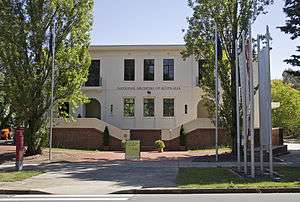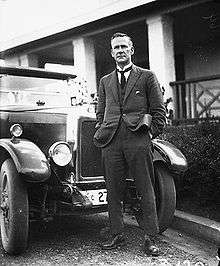National Archives of Australia
The National Archives of Australia is an Australian Government agency that collects, preserves and encourages access to important Australian Government records. It describes itself as the memory of the nation.[3]
| Agency overview | |
|---|---|
| Formed | March 1961 |
| Jurisdiction | Government of Australia |
| Headquarters | Kings Avenue, Parkes, ACT 35°18′18″S 149°07′50″E |
| Employees | 404[1] |
| Annual budget | A$82.733 million (2018–19)[2] |
| Minister responsible |
|
| Agency executive |
|
| Parent agency | Attorney-General's Department |
| Key document |
|
| Website | naa.gov.au |
The Archives' collection of 40 million items traces events and decisions that have shaped the nation and the lives of Australians. Visitors are welcome to explore the collection, online or in person.
Established under the Archives Act 1983, the National Archives reports to its Minister, the Attorney-General. Like all government agencies, it is accountable to the Australian Parliament. The National Archives of Australia Advisory Council provides advice to the Minister responsible for the Archives and the Director-General.
Under the Act, the National Archives has two main roles:
- to collect and preserve Australia's most valuable government records and encourage their use by the public
- to promote good information management by Commonwealth government agencies, especially in meeting the challenges of the digital age.[4]
In addition to caring for its collection, the National Archives develops exhibitions, publishes books and guides to the collection and delivers educational programs.
History

After World War I the Commonwealth National Library (later National Library of Australia) was responsible for collecting Australian Government records. The library appointed its first archives officer in 1944.
In March 1961 the Commonwealth Archives Office formally separated from the National Library of Australia and was renamed as the Australian Archives in 1975.
The Archives Act 1983 gave legislative protection to Commonwealth government records for the first time, with the Australian Archives responsible for their preservation.
The agency was renamed the National Archives of Australia in February 1998.
Collections
The National Archives of Australia's collection of 40 million items covers records pertaining to the government of Australia, including Federation, Governors-General, Prime Ministers, Cabinet and Ministers.
Among the most popular with the public are defence service and immigration records which often contain valuable family history.
The Archives' repositories are not open to the public but items can be requested for digitisation or for viewing in reading rooms. Most records over 26 years old (gradually reducing to 20 years) are released for public access on request. However some have certain information exempted from access. These exemptions may include documents relating to defence and security and sensitive personal information.
Cabinet notebooks have a longer closed period, gradually decreasing from 50 to 30 years by 2021. Access to items of cultural sensitivity to Indigenous Australians may also be restricted.
Notable collections

There are several notable collections held by the National Archives of Australia. They include:
- founding documents, including the Royal Commission of Assent, the Constitution Act and other records created when the six colonies federated to create the Commonwealth of Australia on 1 January 1901
- World War I and World War II service records. Some 376,000 service records for men and women who served in World War I have been digitised and are available online at the Discovering Anzacs website.
- the Griffin drawings – Walter Burley Griffin and Marion Mahony Griffin's winning entry for the design of Australia's Federal Capital
- Mildenhall glass plate photographs taken by government photographer Jack Mildenhall – the 7700 images record Canberra during the 1920s and 1930s
- more than 34,000 immigration photographs
- copyright, patent and trademark registration records documenting Australian creativity and ingenuity.
Recent modernization efforts and collaborations
Discovering Anzacs digital partnership
In 2014, the National Archives of Australia, in partnership with Archives New Zealand, created the digital repository Discovering Anzacs to commemorate the centenary of World War I and each nation's role in the war effort at home and abroad. The repository features the complete and fully digitized service records of the Australian and New Zealand Army Corps (ANZAC). Service records are also displayed geographically on a map of the world to indicate each individual's place of birth, enlistment, death and burial. Users are encouraged to transcribe the official records to improve access and add personal comments, photos and stories to give greater context to each record.[5]
Digital initiatives
Digital Continuity 2020
On 27 October 2015, the National Archives of Australia announced its Digital Continuity 2020 program to modernize the information management practices of the government for the digital age. The policies of Digital Continuity 2020 issued by the authority of the National Archives apply to the whole of the Australian government and seek to improve efficiency and access of all services.[6]
Deadline 2025
Deadline 2025 is a collaboration between the National Archives of Australia and the National Film and Sound Archive to prioritize digitization of valuable media stored on magnetic tape which may deteriorate to the point of being unusable by 2025.[7]
Diversity initiatives
In 2014, the National Archives of Australia announced its Reconciliation Action Plan (RAP) to foster better relations with its indigenous population, the Aboriginal and Torres Strait Islander peoples. The RAP is a multifaceted approach to drawing attention to the history of Aboriginal and Torres Strait Islander peoples, engaging and illustrating their culture respectfully, and providing improved access to their historical records. A main feature of this initiative is the Bringing Them Home name index which leverages the National Archives' collection of records to facilitate genealogical research for Aboriginal and Torres Strait Islander peoples. The National Archives also seeks to have 3% of their workforce be those who identify themselves as indigenous to foster diversity and increase representation in the archival profession.[8][9]
Facilities
The Archives' National Office is in Canberra. It has temporarily been relocated to Old Parliament House until the end of 2018 when it will return to East Block. In 1998 the Canberra reading room, galleries and public areas of National Archives moved into a heritage listed building East Block in the Parliamentary Triangle. The building, one of the national capital's original offices, was built in 1926 beside the Provisional Parliament House. Over the years East Block housed various government departments and served as Canberra's first post office and telephone exchange.
In addition to the National Office of Canberra in the Australian Capital Territory (ACT), the National Archives has offices and reading rooms in each state capital:
- South Australia - Adelaide
- Queensland - Brisbane
- Northern Territory - Darwin
- Tasmania - Hobart
- Victoria - Melbourne
- Western Australia - Perth
- New South Wales - Sydney[10]
.jpg)
On Friday, 9 June 2017 (International Archives Day), the National Archives of Australia officially opened the new, purpose-built National Archives Preservation Facility in Canberra, separate from the National Office which houses the reading room and galleries. The building is 17,000 square meters and will add storage for more than 100 kilometers of paper and audiovisual records.[11] On 21 September 2018, the National Archives Preservation Facility was officially renamed the Peter Durack Building after the Hon Peter Durack QC who introduced the bill creating Australia's National Archives in 1983.[12]
Australian Series System
In 1966, Peter Scott of the Commonwealth Archives Office (predecessor to the National Archives of Australia) developed the Australian Series System (in practice, referred to as the Commonwealth Records Series System by the National Archives)[13] in his paper "The Record Group Concept: A Case for Abandonment".[14] This system represented a change in traditional archival theories of provenance that groups records by the more flexible record series rather than the record group which required all records to be filed under only one creating agency (business, government agency, individual, etc.). The new system recognizes that creating agencies change names, split and dissolve over time and provides a flexible framework to arrange their records across the different agencies which all share the same organizational content. These record series are relational in that they are linked to their historical creating agencies in their various forms to reflect changes in organizational structure over time.[15]
Governance
National Directors
- 1944–68 – Ian MacLean, Chief Archivist
- 1968–70 – Keith Penny, Chief Archivist
- 1970–71 – Keith Pearson, Director, Commonwealth Archives Office
- 1971–75 – John Dunner, Director, Commonwealth Archives Office
- 1975–84 – Robert Neale, Director-General, Australian Archives
- 1984–89 – Brian Cox, Director-General, Australian Archives
- 1990–2000 – George Nichols, Director-General, Australian Archives/National Archives of Australia
- 2000–03 – Anne-Marie Schwirtlich, acting Director-General, National Archives of Australia
- 2003–11 – Ross Gibbs, Director-General, National Archives of Australia
- 2011–Jan 2012 – Stephen Ellis, acting Director-General, National Archives of Australia
- 2012–present – David Fricker, Director-General, National Archives of Australia
Council
2018-2019
- Denver Beanland (Chair)
- Christopher Puplick (Deputy Chair)
- Jade Balfour
- Professor (Emeritus) Peter Boyce
- Adam Creighton
- Suzanne Hampel
- Anne Henderson
- David Irvine
See also
References
- "National Archives of Australia National Archives of Australia Advisory Council Annual Report 2017–18". National Archives of Australia. Retrieved 13 November 2018.
- "Portfolio Budget Statement 2018-2019 National Archives of Australia" (PDF). Australian Government Attorney-General's Department. Retrieved 13 November 2018.
- "About Us". National Archives of Australia. 17 October 2018.
- "Selecting National Archives". National Archives of Australia. Retrieved 20 November 2018.
- "About". Discovering Anzacs. Retrieved 20 November 2018.
- "Digital continuity 2020 the future of e-government" (PDF). National Archives of Australia. Retrieved 25 November 2018.
- "Annual Report 2017-18" (PDF). National Archives of Australia. 12 September 2018. Retrieved 25 November 2018.
- Fricker, David (1 July 2014). "Reconciliation Action Plan 2014-15". National Archives of Australia. Retrieved 25 November 2018.
- "Annual Report 2017-18" (PDF). National Archives of Australia. 12 September 2018. Retrieved 25 November 2018.
- "Locations and Opening Hours". www.naa.gov.au. Retrieved 20 November 2018.
- "Safeguarding the nation's memory". National Archives of Australia. 9 June 2017.
- "National Archives facility named in honour of former Attorney-General Peter Durack QC". National Archives of Australia. 21 September 2018.
- "Organising our holdings". www.naa.gov.au. Retrieved 17 October 2018.
- Scott, Peter (October 1966). "The Record Group Concept: A Case for Abandonment". The American Archivist. 29 (4): 493–504. doi:10.17723/aarc.29.4.y886054240174401. JSTOR 40290645.
- Cook, Terry (Spring 1997). "What is Past is Prologue: A History of Archival Ideas Since 1898, and the Future Paradigm Shift". Archivaria. 43: 17–63.
External links
| Wikimedia Commons has media related to National Archives of Australia. |